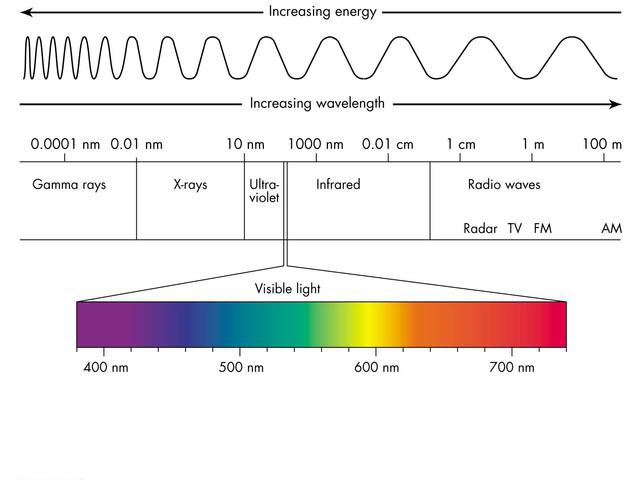As we noted in the introduction, light is not matter and has no mass. How do students perceive the concept of light? Do students consider light to just exist? Do they have a concept that light ‘travels’ and that it travels at a certain speed and in a straight line? How do we see? This section will explore the nature of light, but to get students’ initial perceptions of light and to think critically about its nature, do Activity 1, What is light? Exploring student perceptions of light.
Light is a packet of energy, though that is a bit simplistic because everything is a packet of energy when broken down to its simplest or smallest elementary particle. The simplest form of light is a photon, which is an electromagnetic wave that as it moves – oscillates – it produces an electrical and magnetic field. One field does not exist without the other and together, the electromagnetic field makes up the electromagnetic spectrum.
The part of the electromagnetic spectrum that enables us to see and produce the colours of the rainbow sits in a narrow part of the spectrum we call visible light.
For simplicity, let us consider only the electrical part of the electro-magnetic wave. Waves on water that we can observe are a reasonable analogy to how light travels as a wave. As with a water wave, the electrical wave has a peak and a trough (up and down), and it has a forward motion, but it is the energy that propagates forwards rather than anything physical. Remember that light is massless and the key point here about a photon (light) is about its energy, not the space or size of the elementary particle because a photon does not actually occupy space in the same way you think of a classical object such as a bacterium, rock or planet.
Other properties of a photon include the following:
- It has no charge (unlike electrons and protons).
- Its speed in a vacuum is 299,792,458 metres per second (or about 300 million metres per second)
- It travels in a straight line.
The wavelength of light determines the type of light. See Figures 1 and 2 below.

Figure 1. The distance between light waves (their wavelengths) determines the type of light it is. The distance will range from kilometres to lengths about the width of an atom, but they all travel at the same speed, the speed of light. (Image: National Geographic Education Blog)

Figure 2. The energy of the wavelength increases with its frequency (number of oscillations per unit of time). Note the tiny proportion of the spectrum that makes up the visible spectrum. (Image: Cyberphysics)
Either side of visible light on the electromagnetic spectrum are a range of other forms of light. Sitting just outside the visible spectrum with a slightly longer wavelength is infrared light – or what we perceive as heat. On the other side of the spectrum from visible light with shorter wavelengths is UV light, which is what causes sunburn. The shorter the wavelength of light (and higher the frequency) the greater its energy. Regardless, the different forms of light are all the same thing, electromagnetic radiation, just with a different wavelength and energy.
Students can use a chocolate bar and microwave to see evidence of light as a wave and calculate the speed of light. See Activity 2, Chocolate light: Observing light as a wave. Younger students can simply observe how the chocolate melts in blobs that are a at specific distance apart and observe the light acting as a wave. Older or more advance students can measure the wavelength and determine the speed of light.
Random fact: If you are lucky enough to be, for example, a manta shrimp or bee you can see or perceive your world in the UV through to the infrared wavelengths. The Australian Academy of Science has produced an excellent article and video – see below – on the visual systems of the mantis shrimp and similar animals and how our understanding of these systems has helped humans improve cancer detection and satellite imagery.
Random fact: Humans generate heat and we emit that in the form of infrared light. We can’t see it because it is outside the invisible spectrum. But it is how night vision goggles work. They detect the infrared radiation (heat) from objects, which is why we can still see any object that gives off heat at night. See thermal image camera in use below to check out giraffes at night.
More information
See RiAus and their Explainer on the different forms of light in the EM spectrum, and here in their Short history of light.
For another neat explanation of electromagnetic radiation see Bernie Hobbs in action (Catalyst episode. Begins at 23:30 mark in show)
The key concepts that students need to grasp to understand light and its interaction with our physical environment are reflection, absorption refraction and diffraction. These are explained in the section, Reflection, absorption, refraction, diffraction [link].
All FLEET Schools’ activities and web content are licensed under CCBY 4.0: This license enables reusers to distribute, remix, adapt, and build upon the material in any medium or format, so long as attribution is given to the creator, Centre of Excellence for Future Low-Energy Electronics Technologies
Go to next section, Reflection, absorption, refraction, diffraction. The basics
Back to FLEET Schools

